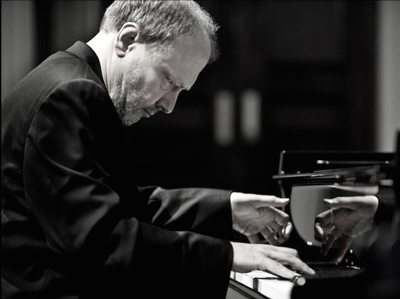by Nicholas Stevens

Applause warmed Severance many times on Thursday, October 24, when guest conductor Dima Slobodeniouk took the podium for two staples and a rarity. Seldom do programs in the traditional overture-concerto-symphony format dominated by household names impart such feelings of weird, wonderful immediacy.
From the first ascending figures of Rachmaninoff’s Isle of the Dead through blossoming chords and blistering brass swells, Slobodeniouk acted as a sculptor of sounds. His right hand floated, tracing shapes in the air. These translated into musical moments with startling directness: a sweep of the fingers conjured fog in the strings, and a tilt of the palm manifested a sublime chord. The Orchestra rendered Rachmaninoff’s odd rhythms so naturally that they scarcely registered as anything out of the ordinary.
Sublimity arrived with the entrance of pianist Marc-André Hamelin, the soloist in Liszt’s Concerto in E-flat. All the adjectives available in the dictionary would fail to describe the miracles of confidence, assurance, and apparent ease that made this interpretation feel ideal. The nocturne-like piano solos that interrupt the first movement’s orchestral roaring had such tenderness and intimacy that it was as though Hamelin opened a portal to a 19th-century salon, right there on stage. If a small moment can epitomize great pianism, then Hamelin’s soft, climbing octaves at the end of the movement should be entered into the annals.
Hamelin embraced the fragmentary nature of the second-movement melody. Shifts in mood occurred as if by alchemical transfiguration. Impish and carefree, the third movement ended with a note so soft and quick that it seemed more like a disappearance than a conclusion. For the finale, Hamelin achieved top volume without producing the crash-bang unpleasantness that can mar pianists’ passionate moments. What looked like matter-of-fact flopping and tapping emerged as virtuosic strains, rendered flawlessly.
Hamelin’s encore after the Liszt, Debussy’s Minstrels from his first book of Préludes, included a humorous moment of extended technique: Hamelin held a bass string with his hand while pressing the key, producing a clear, dry thump.
Nielsen’s Symphony No. 5 opens with a long-held pattern in the violas, here played with wintry dryness for minutes before passing from section to a soloist: Yusuf, one of the central figures in the Orchestra’s rendition of the piece. Bassoonists John Clouser and Gareth Thomas seized the spotlight in a duo, and somehow, Joela Jones made the celesta of Sugarplum Fairy fame sound aggressive.
Showtime arrived when Damoulakis began the symphony’s defining snare drum solo, a semi-improvised tattoo in open conflict with the rest of the orchestra. Commanding but not earsplitting, Damoulakis’s sound filled the room. Yusuf’s solo over the offstage, retreating portion of the drum solo served as the perfect answer to this show of force. Although Nielsen allows this sort of drama to dissipate past this central point, the Orchestra gamely saw the piece through to a triumphant, ringing end.
Published on ClevelandClassical.com November 12, 2019.
Click here for a printable copy of this article



